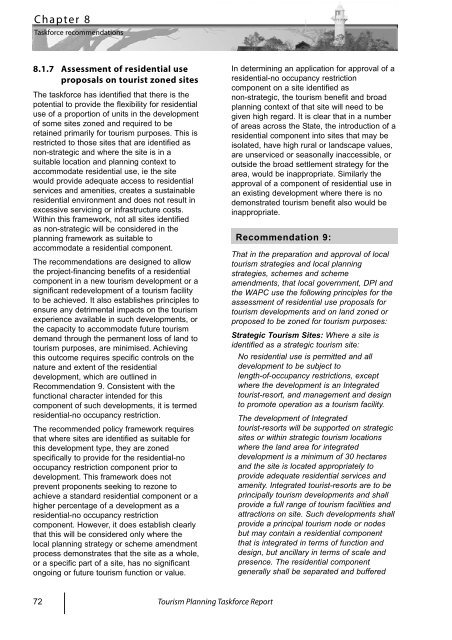Tourism Planning Taskforce Report - Western Australian Planning ...
Tourism Planning Taskforce Report - Western Australian Planning ...
Tourism Planning Taskforce Report - Western Australian Planning ...
- No tags were found...
Create successful ePaper yourself
Turn your PDF publications into a flip-book with our unique Google optimized e-Paper software.
Chapter 8<strong>Taskforce</strong> recommendations8.1.7 Assessment of residential useproposals on tourist zoned sitesThe taskforce has identified that there is thepotential to provide the flexibility for residentialuse of a proportion of units in the developmentof some sites zoned and required to beretained primarily for tourism purposes. This isrestricted to those sites that are identified asnon-strategic and where the site is in asuitable location and planning context toaccommodate residential use, ie the sitewould provide adequate access to residentialservices and amenities, creates a sustainableresidential environment and does not result inexcessive servicing or infrastructure costs.Within this framework, not all sites identifiedas non-strategic will be considered in theplanning framework as suitable toaccommodate a residential component.The recommendations are designed to allowthe project-financing benefits of a residentialcomponent in a new tourism development or asignificant redevelopment of a tourism facilityto be achieved. It also establishes principles toensure any detrimental impacts on the tourismexperience available in such developments, orthe capacity to accommodate future tourismdemand through the permanent loss of land totourism purposes, are minimised. Achievingthis outcome requires specific controls on thenature and extent of the residentialdevelopment, which are outlined inRecommendation 9. Consistent with thefunctional character intended for thiscomponent of such developments, it is termedresidential-no occupancy restriction.The recommended policy framework requiresthat where sites are identified as suitable forthis development type, they are zonedspecifically to provide for the residential-nooccupancy restriction component prior todevelopment. This framework does notprevent proponents seeking to rezone toachieve a standard residential component or ahigher percentage of a development as aresidential-no occupancy restrictioncomponent. However, it does establish clearlythat this will be considered only where thelocal planning strategy or scheme amendmentprocess demonstrates that the site as a whole,or a specific part of a site, has no significantongoing or future tourism function or value.In determining an application for approval of aresidential-no occupancy restrictioncomponent on a site identified asnon-strategic, the tourism benefit and broadplanning context of that site will need to begiven high regard. It is clear that in a numberof areas across the State, the introduction of aresidential component into sites that may beisolated, have high rural or landscape values,are unserviced or seasonally inaccessible, oroutside the broad settlement strategy for thearea, would be inappropriate. Similarly theapproval of a component of residential use inan existing development where there is nodemonstrated tourism benefit also would beinappropriate.Recommendation 9:That in the preparation and approval of localtourism strategies and local planningstrategies, schemes and schemeamendments, that local government, DPI andthe WAPC use the following principles for theassessment of residential use proposals fortourism developments and on land zoned orproposed to be zoned for tourism purposes:Strategic <strong>Tourism</strong> Sites: Where a site isidentified as a strategic tourism site:No residential use is permitted and alldevelopment to be subject tolength-of-occupancy restrictions, exceptwhere the development is an Integratedtourist-resort, and management and designto promote operation as a tourism facility.The development of Integratedtourist-resorts will be supported on strategicsites or within strategic tourism locationswhere the land area for integrateddevelopment is a minimum of 30 hectaresand the site is located appropriately toprovide adequate residential services andamenity. Integrated tourist-resorts are to beprincipally tourism developments and shallprovide a full range of tourism facilities andattractions on site. Such developments shallprovide a principal tourism node or nodesbut may contain a residential componentthat is integrated in terms of function anddesign, but ancillary in terms of scale andpresence. The residential componentgenerally shall be separated and buffered72 <strong>Tourism</strong> <strong>Planning</strong> <strong>Taskforce</strong> <strong>Report</strong>

















